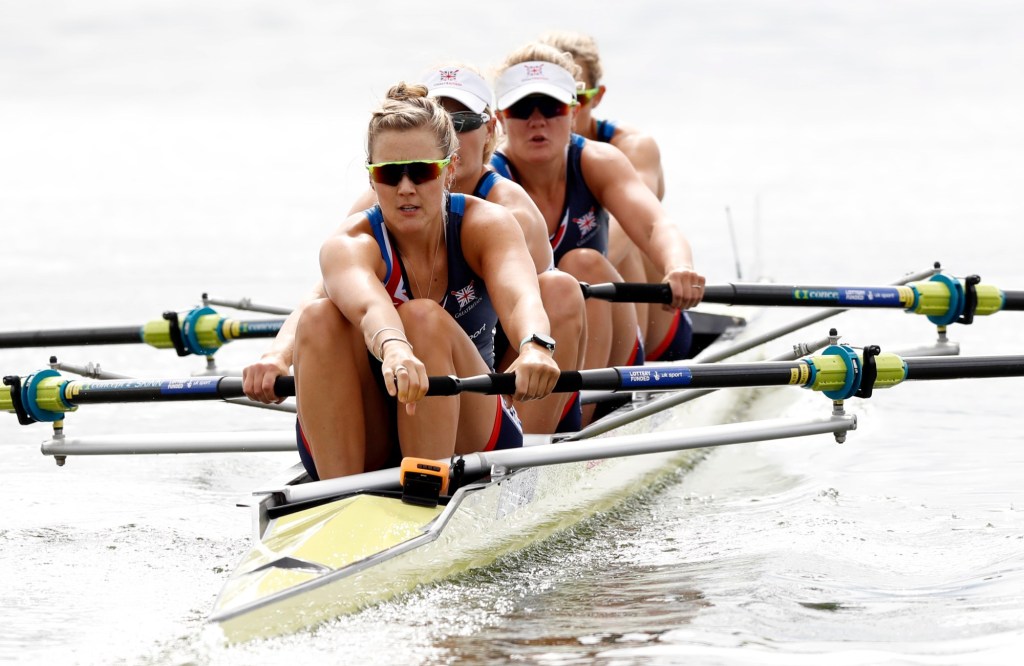
by Talia Barrington
For The Washington Post
Growing up in England, Caragh McMurtry wasn’t your typical future Olympic rower. Born to parents who worked in a local factory, raised in low-income housing, frequently in trouble for being a “terror,” she didn’t exactly fit the mold of a sport known for a certain elitism.
But when an after-school program funded by British Rowing was offered at her school, McMurtry gave it a try. With rowing, unlike at school — where she struggled to connect with peers — rules were clear. Everyone had a defined job, it was always the same, and because the rowers sat in a single row, she didn’t feel that people were looking at her.
“It was cathartic,” she told me. “Pushing hard gave me that sensory feedback,” and the repetitive action was “calming.”
At first, everything seemed to go well. She made it to the World Rowing Junior Championships and the under 23s and senior championships, and the medals started rolling in. But then things went a little haywire. Her coaches labeled her difficult and told her she asked too many questions and was too blunt and honest with her peers. She was diagnosed with bipolar disorder, which is known for its extreme mood swings, and she was put on lithium and a cocktail of other drugs that did not work.
It would take five more years before a doctor would figure out why she struggled to connect with her teammates and others around her but was so focused, so “regulated” when it came to extreme and continued physical exertion: She had a form of autism. Experts call a key aspect of what McMurtry experiences when engaged in physical activity “hyperfocus,” and it’s an overlapping hallmark of both autism and ADHD.
“People with ADHD and autism have an incredibly high ability to focus on tasks that they find interesting or stimulating,” said Laura Huckins, an associate professor of psychiatry at the Yale Center for Genomic Health. “They tend to be drawn towards professions that require or include novelty, that include regular challenges, and that require high performance under stress and pressure.”
McMurtry says the sensory perception, literal thinking and perfectionism qualities that are related to autism are what led her to become an athlete.
In recent years, a number of high-profile athletes, including Olympic medal-winning gymnast Simone Biles, swimmer Michael Phelps and sprinter Noah Lyles, and Paralympics medal-winning swimmer Jessica-Jane Applegate, have spoken out about their neurodivergent diagnoses. Experts are beginning to question whether neurodivergent athletes are the exception, or if the profile of neurodiversity promotes athletic advantage.
Elizabeth Ekman, a psychotherapist and former consultant to the Swedish Olympic Committee, said she believes many elite athletes are likely to be neurodivergent. It’s a claim she said would be hard to verify. But in 2021, Ekman published a study showing that at the very least, ADHD traits are more prevalent among athletes. Her team evaluated 200 previously undiagnosed elite high school athletes and nonathletes for signs of ADHD when in an academic setting and then also on the field of play. The nonathletes showed no symptoms in either setting. The athletes showed extreme symptoms in school settings but no symptoms in sports. What this study shows, Ekman says, is that ADHD isn’t some monolithic diagnosis, but impacted by the situation.
Ekman says the term “neurodivergent” — used to describe people whose brains process information differently, such as those with traits often associated with autism spectrum disorder (ASD) and ADHD — shouldn’t be thought of as a negative, but as a difference of emotional and cognitive attributes that can be beneficial in some situations and more challenging in others. Her idea is backed up by a 2019 meta-analysis of athletes and ADHD in the British Journal of Sports Medicine. Research has found that the number of ADHD diagnoses among athletes is much higher than the general population. Major League Baseball, for example, reported that more than three times the number of players received an ADHD diagnosis in 2018 than was the case in the general population. Thanks to the stringent testing required to allow medication use, and a stigma against mental health care, it is likely this number is underestimated, Ekman said.
In her study, she calls ADHD an “evolutionary mismatch,” building on theories first proposed in 1978 by Thom Hartmann, whose book “ADHD: A Hunter in a Farmer’s World” suggested that in our evolutionary past, ADHD-like symptoms such as hyperfocus, greater capacity for physical exertion and even impulsivity may have helped our hunting and gathering ancestors, but that once humans settled and became farmers, those traits became hindrances.
McMurtry is far from alone in having a late diagnosis suddenly make things in her life clear.

Adam Rippon, a 2018 Olympic figure skating bronze medalist, described the strong need for approval he and his skating peers felt for perfection and for control, and their pervasive sense that 100 percent effort wasn’t enough. “What 8-year-old says, ‘Yeah! I want to wake up at 4:45 a.m. and go practice the same action over and over again every day before school!’?” he said. It wasn’t until Rippon retired from the sport that he began to question how common these behaviors are. He said he was eventually diagnosed with ADHD and anxiety, and he believes that being an athlete masked many of the negative effects of his neurodivergence — that without sports he might have been diagnosed sooner. But, he added, sports also improved his mental health and provided a means to success.
Research shows he may be right. In a study published in the Journal of Attention Disorders in 2009, researchers found that children ages 6 to 14 with ADHD displayed a significantly lower incidence of depression and anxiety if they regularly engaged in three or more sports, compared with those who did not. The same reduction in depression and anxiety was not found in the control group of neurotypical children taking part in extra sports activities.
Sports might be the closest many people get to a hunter-gatherer lifestyle, Ekman says. Being impulsive and taking risks — a problem when in a classroom or other settings — can help athletes break records and gain a competitive edge. Goals in sports are clear: Jump higher. Catch the ball quicker. Run farther. These can require a higher-than-normal capacity for repetition.
As McMurtry noted, athletes know their defined place on a team and the rules of their sport. And sports provide an outlet for being social, but with a “purpose.” For athletes who can train for hours on fumes but become overwhelmed and exhausted by a dinner party or managing daily chores, sports are a safe space where they can thrive.
“We are only just beginning to understand the unique strengths that autism and ADHD bring to all populations,” says Erin Hoare, a research scientist at Deakin University in Melbourne, Australia, and a former professional Australian football player. Still, much of the discourse around neurodivergence treats it as a problem to be overcome. There are undeniable challenges: Those with ADHD and autism tend to struggle with low self-esteem, and they are at high risk of drug addiction and mental illness. “When you are a person who is neurodivergent in an environment that doesn’t support your needs, there are going to be difficulties,” Hoare said. “But once we start to apply a neuro-inclusive lens [to training], we can start to find opportunities within sports that support differences and allow people to be the best they can be.”
Cortnee White, a sports psychologist who frequently works with neurodivergent athletes, agreed. White sees many young athletes in her practice give up or get cut from teams before they reach their full potential. “Sports culture shouldn’t fear the differences of ADHD brains. What they should fear is losing the opportunity to utilize everyone’s gifts,” she said.
It’s exactly this scenario that led to McMurtry’s earlier-than-expected retirement. At the height of the coronavirus pandemic, during which training was restricted and largely self-driven, she was in the best shape of her life. She’d shaved 17 seconds from her time and despite a disappointing outcome for her at the Tokyo Olympics, she had finally begun to race the way she always knew she could. But a new head coach implemented a team-wide training regimen that limited practice breaks that McMurtry used to decompress from sensory overload. She couldn’t adapt. “If you are someone who has ADHD or autism, more is not more,” she said. “I realized that no matter how much I got it right, unless the system changed, I would never really succeed in the way that I felt like I was capable. So, I retired and co-founded Neurodiverse Sport with my husband.”
McMurtry’s husband, Mikey Mottram — a former rower on the British national team and currently an elite gravel cyclist — has been diagnosed with ADHD, dyslexia, which affects how the brain processes language, and dyspraxia, which can affect dexterity and motor skills. He says his ability to train for hours on end is foundational to his success.
The Neurodiverse Sport team is made up largely of former and current neurodivergent athletes such as McMurtry and Mottram. The athletes give lectures, webinars and suggestions to help coaches and sports organizations provide better support for athletes of all ages who have varying neurodivergent traits.
Of her autism, McMurtry said, “for me, it can be a super strength. It can also be my Achilles’ heel, but it’s what makes me unique. And one doesn’t — one can’t — come without the other.”




